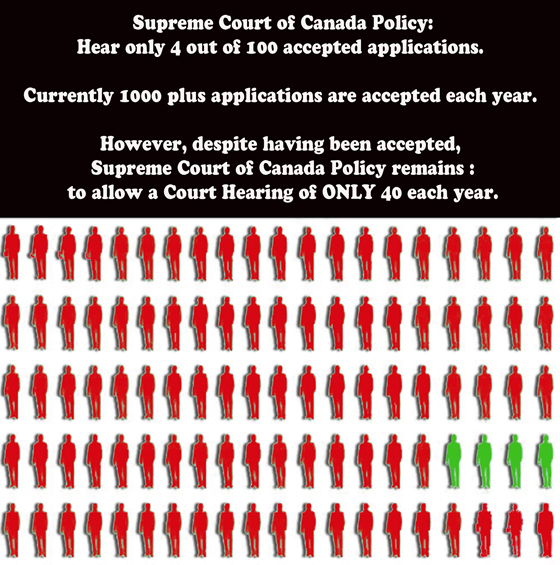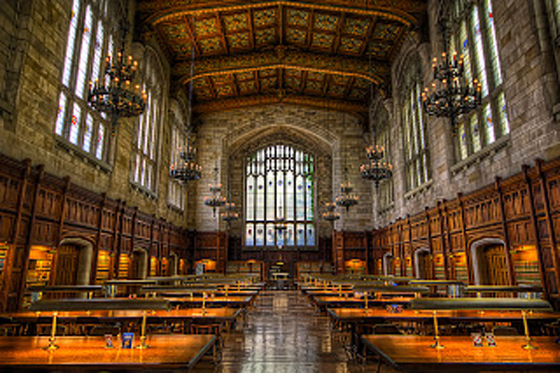What are the basic steps?
1. Filing of your application for leave to appeal
You must “file” the original and five (5) copies of your application for leave to appeal prepared in accordance with Rule 25 of the Rules of the Supreme Court of Canada and all supporting material with the Registrar of the Supreme Court of Canada within 60 days of the date of the court of appeal's judgment. The 60 days are counted from- the date the judgment was pronounced orally in the court of appeal or,
- if the judgment was not pronounced orally, the date of the written judgment.
The month of July is not counted in calculating this deadline.
The application for leave to appeal must include everything that is shown in the application for leave to appeal sample book. However, the memorandum of argument must not exceed 20 pages.
If you miss your deadline for filing a document, you must file and serve a motion for an extension of time together with an affidavit explaining the reasons for the delay. Your motion for an extension of time will be considered together with your leave application.
2. Service of your application for leave to appeal
You must, within 60 days of the date of the court of appeal's judgment, “serve” a copy of your application for leave to appeal and all supporting material on all parties who were before the court of appeal and are named in the style of cause (See Rule 22(2)) of your application for leave to appeal. If you have chosen in your application for leave to appeal not to name one of the parties who were before the court of appeal, you must nevertheless send a copy of your notice of application for leave to appeal to that party.3. A Supreme Court file will be opened . . .
A Court file will be opened once your complete application for leave to appeal is filed with the Registrar. An application for leave to appeal is complete once you have complied with all the requirem and has been reviewed by the Registry. An application for leave to appeal is complete once your have complied with all the requirements of the Court's Rules and have filed all the required documents. The Registry will advise you in writing of your file number. You can use that file number to search the Court docket on SCC Case Information.In some cases, a Court file will be opened if you have complied with most of the requirements of the Rules or if you have filed most of the required documents. However, your application for leave to appeal will be classified as incomplete and you must still file and serve all the required documents and comply with all the requirements of the Rules within 60 days of the court of appeal's judgment. If you miss this deadline, the Registrar may send you a notice advising you that your application for leave to appeal will be dismissed as abandoned unless you get a judge to extend the time to complete your application for leave to appeal.
A Court file will not be opened . . .
if many of the required documents are missing or if the application for leave to appeal book is not assembled properly. The Registrar may return the material to you and this may cause you to miss the deadline for filing.
OR
if your case is not properly before the Supreme Court of Canada: e.g., if
you do not have a final judgment from an appeal court or if the Court does
not have “jurisdiction”.4. The other party's response
The other party (“respondent”) may file a response (an original and five (5) copies) and serve it on all other parties within 30 days of the date a file number is assigned to your application for leave to appal. The respondent will be advised in writing.The month of July and the holiday recess (from December 21 to January 7) are not counted in calculating the deadline for filing and service of the response.
5. Filing and service of your reply
You are permitted to file a reply (an original and five (5) copies) to the respondent's response and serve it on all other parties within 10 days of receiving the response. The memorandum of argument in your reply must not exceed 5 pages. A reply may be prepared in the form of correspondence.If you miss the deadline for filing your reply, the Court may render a decision without having received your reply.
The month of July and the holiday recess (from December 21 to January 7) are not counted in calculating the deadline for filing and service of your reply.
6. Submission of your application for leave to appeal to the Court for decision
At the expiry of the deadline for filing the reply, your application for leave to appeal, together with the response and reply, will be submitted (sent) by the Registrar to a panel of three judges for decision.No one may file and serve additional material once the application for leave to appeal has been submitted unless permission is given by the Registrar (Rule 32 of the Rules of the Supreme Court of Canada). To obtain permission, you must file a motion with the Registrar of the Supreme Court of Canada.
7. Do I have to appear in Court?
The whole process is done in writing only. You do not have to appear at the Court to argue your application for leave to appeal. Unless in very rare cases however, the Court may ask that an oral hearing be held. If such an order is made, you will be given advance notice.In an appeal relating to an indictable offence, you may ask the Court for an oral hearing pursuant to section 43(1.2) of the Act if
- the court of appeal set aside an acquittal and ordered a new trial, and
- you are not otherwise appealing as of right on a question of law on which a judge of the court of appeal has dissented.
8. The Court's decision
Decisions are rendered in writing. You can generally expect the decision in your case to be released between one and three months after your application for leave to appeal was submitted (sent) to the panel of judges. You will receive a telephone call from the Registry a few days before the decision to advise you of the date your judgment will be rendered. You will not receive a second telephone call from the Registry to advise you of the content of the decision. If you wish to be informed of the Court’s decision on the day of the judgment, you may contact the Registry by telephone at 613-996-8666 after the judgment is released. Decisions are usually available on SCC Case Information on the day they are rendered.You can subscribe to the Court's mailing list in order to be notified.
It will not be necessary for you to come to the Registry to get your judgment. A copy will be sent to you by mail.
The Court does not issue reasons for its decisions to allow or dismiss applications for leave to appeal.
| If the application is... | Then... |
|---|---|
| granted |
|
| dismissed | the judgment on the application
for leave to appeal is final: |
If your application for leave to appeal is dismissed and you think one of the “exceedingly rare” circumstances exists in your case, we strongly urge you to seek legal advice.
Example of a rare circumstance:
A change was made to the law made at the same time as you were making your application for leave to appeal.
9. Costs
You should be aware that in addition to filing fees paid to the Registrar, you may be ordered to pay costs claimed by the respondent if the Court dismisses your application for leave to appeal.Costs for applications for leave to appeal range from $800 to over $2000.
Exception:
Costs are generally not ordered in criminal cases.



























No comments:
Post a Comment